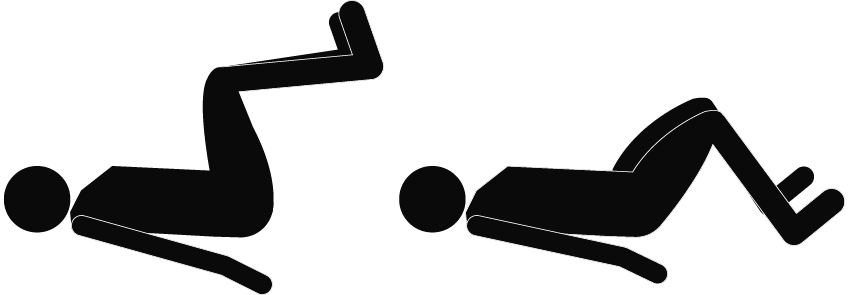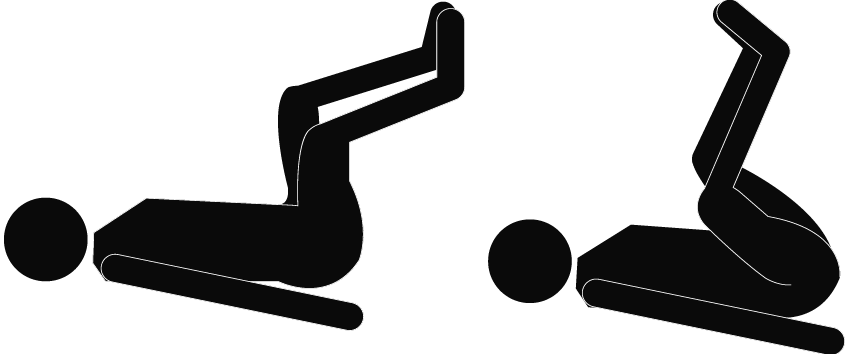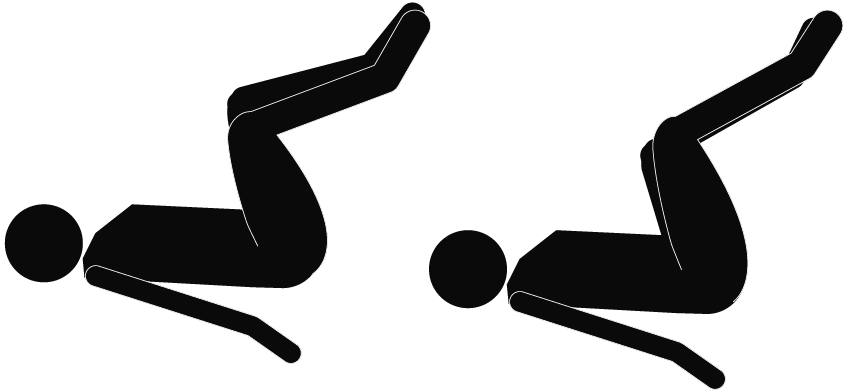0
You do not have any products in your shopping cart yet.
BACK | BELLY | CHEST | STRETCHING
While lying on your back, arch your pelvis upright and hold this position - isometric exercise
Exercise for the rectus abdominis (abs)
Starting position
On your back with legs raised. The feet are pulled towards the legs, with the heels gently pushing into the ground. The arms are bent, with the upper arms lying on the ground and adjacent to the body.
Exercise
The upper body is raised several centimeters from the ground. Hold this position for about ten seconds and then release. Hold this position for about ten seconds and then release.
Things to remember
Do not hold your breath, but continue to breathe evenly.
While lying on your back, arch your pelvis upright and hold this position - isometric exercise
Exercise for the rectus abdominis (abs)
Starting position
On your back with legs raised. The feet are pulled towards the legs, with the heels gently pushing into the ground. The arms are bent, with the upper arms lying on the ground adjacent to the body.
Exercise
By tightening the abdominal muscles, the lower back is pressed into the mat. The palms face towards the ceiling. Hold this position for about ten seconds and then release.
Things to remember
Do not hold your breath, but continue to breathe evenly.
Stretch waist on one side
Exercise for the rectus abdominis (abs)
Starting position
On your back with hips and knees bent at right angles. By tightening the abdomen, the lumbar spine is pressed into the floor. The arms are on the ground and adjacent to the body.
Exercise
Press the lumbar spine firmly into the ground and then alternately stretch the hips on each side by bringing each leg slowly towards the floor and then back into the air again. Exhale when stretching the hips, and inhale when bending them.
Things to remember
Stretch hips only as far as you can while still keeping the lumbar spine on the floor. A passive pelvic position (back bent backwards, lumbar spine rising from the ground) indicates an excessive extension of the hips. In this case, simply reduce the range of motion.
Stretch waist on both sides
Exercise for the rectus abdominis (abs)
Starting position
On your back with hips and knees bent at right angles. By tightening the abdomen, the lumbar spine is pressed into the floor. The arms are on the ground and adjacent to the body.
Exercise
Press the lumbar spine firmly into the ground. Then, alternate between stretching hips and bending them again by slowly bringing the legs toward the ground and then back into the air. Exhale when stretching the hips, and inhale when bending them.
Things to remember
Stretch the hips only as far as you can while still keeping your lumbar spine on the floor. A passive pelvic position (back bent backwards, lumbar spine rising from the ground) indicates an excessive extension of the hips. In this case, simply reduce the range of motion or perform the hip extension on one side.
Pelvis upright, pull knees to the body
Exercise for the rectus abdominis (abs)
Starting position
On your back, with hips and knees bent at right angles. The knees should point slightly outward, with the soles pressed together. By tightening the abdomen, the lumbar spine is pressed to the floor. The arms are on the ground and adjacent to the body.
Exercise
By significantly raising the pelvis, the knees are pulled toward the body and then extended outward again. Exhale when retracting the knees, and inhale while extending them back outward.
Things to remember
The movement should be performed slowly and in as controlled of a manner as possible.
Pelvis upright, knees raised
Exercise for the rectus abdominis (abs)
Starting position
On your back, with hips and knees bent at right angles. The knees should point slightly outward, with the soles pressed together. By tightening the abdomen, the lumbar spine is pressed to the floor. The arms are beside are on the ground and adjacent to the body.
Exercise
By significantly raising the pelvis, the knees are pushed directly upward. The buttocks are raised a few centimeters from the ground. Exhale during the upward movement, and inhale during the downward movement.
Things to remember
You should try to work toward being able to do the exercise without swing support. If possible, avoid pulling the knees toward the body.
Cross crunches with arms bent
Exercise for the rectus abdominis (abs), the internal oblique abdominal muscle (internal oblique) and the external oblique abdominal muscle (external oblique).
Starting position
On your back with legs raised. The feet are pulled toward the legs, with the heels slightly pushing into the ground. The arms are bent in the shape of a "U." By tightening the abdominal muscles, the lower back is pressed lightly into the ground.
Exercise
The shoulder blades are raised slightly off the ground, and the shoulder girdle is then turned one time to each side. Exhale when raising the upper body, and inhale when lowering it back down.
Cross crunches with arms outstretched
Exercise for the rectus abdominis (abs), the internal oblique abdominal muscle (internal oblique) and the external oblique adbominal muscle (external oblique).
Starting position
On your back with legs raised. The feet are pulled toward the legs, with the heels slightly pushing into the ground. The arms are held outstretched above the head. By tightening the abdominal muscles, the lower back is pressed lightly into the ground.
Exercise
The shoulder blades are raised slightly off the ground, and the shoulder girdle is then turned one time to each side. Exhale when raising the upper body, and inhale when lowering it back down.
Things to remember
The lumbar spine should remain on the ground for the duration of the movement.
On your side, leaning on one forearm with knees bent
Exercise for the transverse abdominal muscle (transversus abdominis)
Starting position
On one side, leaning on your elbows. The shoulder is above the elbow, the legs are bent and the hips outstretched.
Exercise
The pelvis is lifted into the air until knees, hips and shoulders form a diagonal line. From this position, lift your thigh a few centimeters upwards. Inhale when lifting, and exhale when lowering.
Things to remember
Keep the hips outstretched for the duration of the movement. Avoid shifting the buttocks backwards.
On your side, leaning on one forearm with legs outstretched
Exercise for the transverse abdominal muscle (transversus abdominis)
Starting position
On one side, leaning on your elbow. The shoulder is above the elbow, the legs are bent and the hips outstretched.
Exercise
The pelvis is lifted into the air to knees, hips and shoulders form a sloping line. From this position, the upper leg is guided a few centimeters upwards. The pelvis is lifted into the The pelvis is lifted into the air until knees, hips and shoulders form a diagonal line. From this position, the upper leg is guided a few centimeters upwards(Fig. 34). Inhale when lifting the leg, and exhale when lowering it back down.
Things to remember
Keep the hips outstretched for the duration of the movement. Avoid shifting the buttocks backwards.
BACK | BELLY | CHEST | STRETCHING